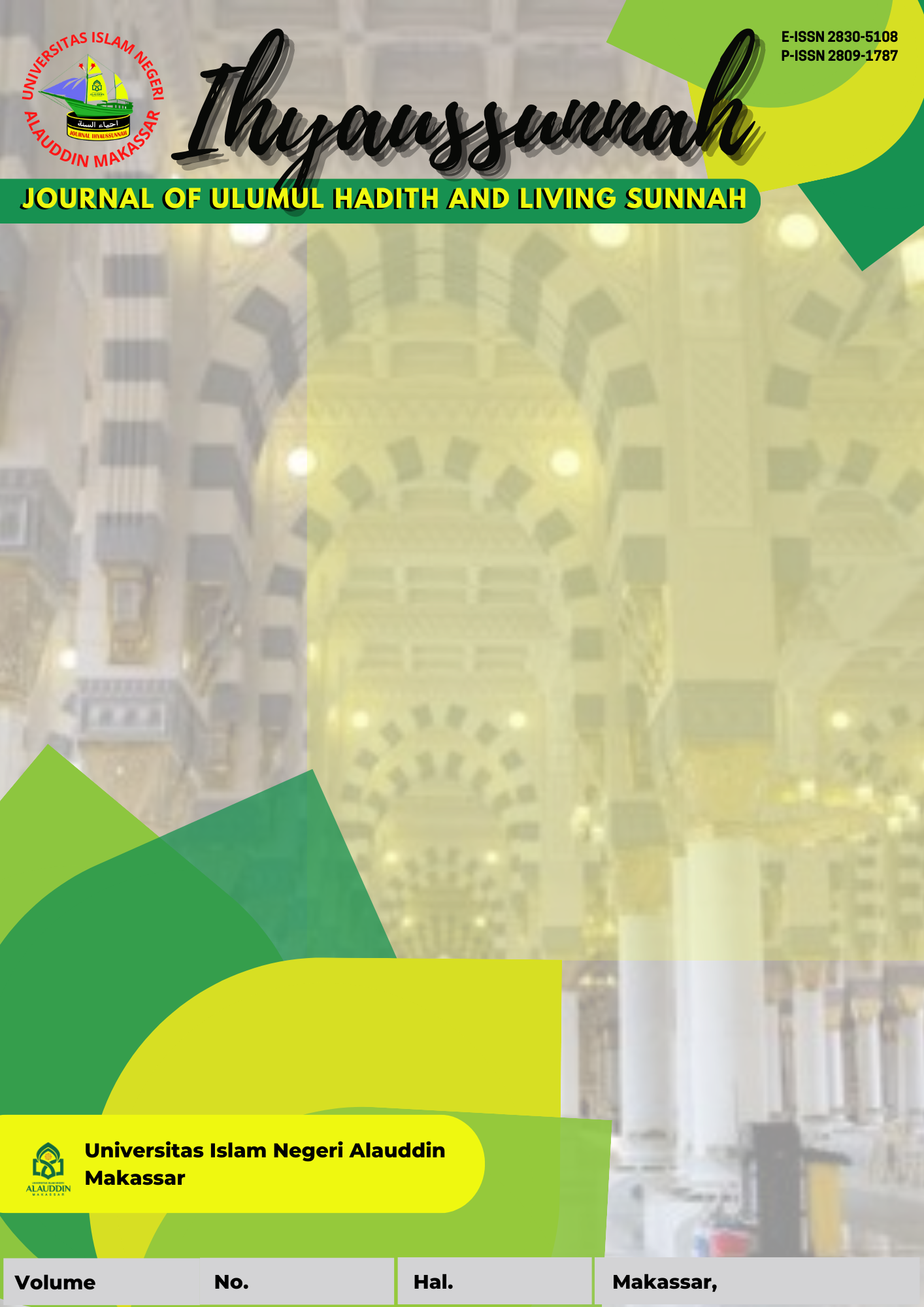Implementation of Rukiah with Hose in Polewali Mandar: A Study of Ihya Al-Sunnah
Abstract
The research discusses the implementation of rukiah with a hose in Lemo Baru Hamlet, Kuajang Village, Binuang District, Polewali Mandar Regency which will be seen in the review of iḥyā as-sunnah by knowing the problems, namely: 1) What is the quality of the hadith about rukiah? 2) How is the understanding of hadith about rukiah with a hose in Lemo Baru Hamlet, Kuajang Village? 3) How is the implementation of sunnah values on rukiah with a hose in Lemo Baru Hamlet, Kuajang Village? This type of research is classified as qualitative based on descriptive field research with the research approach used as sociological approach and phenomenology. The data sources of this research are the Rukiah, Rukiah Patients, Religious Leaders, Traditional Leaders, Village Heads, and the Community. Furthermore, the data collection methods used are observation, interviews, documentation, and reference searches. Then, data processing and analysis techniques are carried out through two processing methods, namely the deductive method and the comparative method, and three stages of data analysis, namely: data presentation, data reduction, and verification then concluding. The results showed that rukiah with a hose in Lemo Baru Hamlet, Kuajang Village with the study of iḥyā as-sunnah. In the aspect of the quality of the hadith which is the object of research, it is considered as a hadith that can be used as a basis for footing and is supported by the involvement of Muslims in the line of transmission. The understanding of the community regarding this matter shows that the hadith contains legal evidence for the permissibility of doing rukiah and is also an effort to revive the hadith or sunnah of the Prophet Muhammad PBUH. The implementation of sunnah values in rukiah with a hose in Lemo Baru Hamlet, Kuajang Village is the legal value of the permissibility of doing rukiah and is an effort to revive the sunnah of the Prophet Muhammad PBUH, there is the value of reading the Qur'an, there is the value of helping, and there is the value of da'wah. This research provides an in-depth understanding of the practice of rukiah with a hose in Lemo Baru Hamlet and its relation to the concept of Iḥyā Sunnah in Islamic tradition. The research findings can be a study material for academics, therapists, and observers of Islamic traditions to understand the various implementations of spiritual practices that develop in the community.
Downloads
References
Adyanta, ‘Penerapan Sunnah Nabi Shallallahualaihi Wasallam, Ruqyah Syariyyah, Di Klinik Surabaya Ruqyah Center’, An-Nida’, 38.2 (2013), 77–89
Aghna Rosi Saputri and others, Membumikan Al-Qur’an Ditanah Melayu (Living Qur’an), ed. by Muhammad Taufiq, 1st edn (Ponorogo: Uwais Inspirasi Indonesia, 2022), h. 18.
Ahmad ‘Ubaydi Hasbillah, Ilmu Living Quran-Hadis Ontologi, Epistemologi, Dan Aksiologi, 3rd edn (Banten: Maktabah Darus-Sunnah, 2021), h. 4.
An-Naisābūrī, juz 4, h. 1718. Hadis di atas juga terdapat dalam Musnad Aḥmad, Sunan Ibn Mājah, Sunan at-Tirmiżī, Sunan al-Kubrā an-Nasā’ī, dan berbagai kitab lainnya.
HaditsSoft’ (Home Sweet Home, 1440)
Ibnu Abdullah, Mukjizat Ibadah: Di Mana Ibadah Bukan Hanya Sekedar Kewajiban, 2nd edn (Pustaka Media, 2018), h. 21.
Muhammad Asy-Syarqawi Ahmad, Ayat Kursi, Makna Dan Khasiat (Jakarta: Pustaka Azam, 2007), h. 44.
Muhammad Syafi’i Hadzimi Djonaka and Dwi Sidik Permana, ‘Rancang Bangun Aplikasi Pendaftaran Pengobatan Dengan Metode Ruqyah Berbasis Android Studi Aasus Al-Hikmah 3113’, JUNIF: Jurnal Nasional Informatika, 2.2 (2021), 92–113.
Sulaimān ibn al-Asyʻaṡ ibn Isḥāq ibn Basyīr ibn Syidād ibn ʻAmru al-Azdī as-Sijistānī Abū Dāwud, ‘Sunan Abī Dāwud’, in 1-4, ed. by Muḥammad Muḥyī al-Dīn ʻAbd al-Ḥamīd (Beirut: al-Maktabah al-ʻAṣriyyah)
Syamsuri Ali, ‘Pengobatan Alternatif Dalam Perspektif Hukum Islam’, Al-‘Adalah, 12.2 (2015), 867–90
Syarifah Ainun Jamilah, Muh. Sadik Sabry, and Muhsin Mahfudz, ‘Menyingkap Ayat-Ayat Ruqyah Di Majelis Zikir Siratal Mustaqim Makassar (Suatu Kajian Fenomenologi)’, Jurnal Tafsere, 7.2 (2019), 73–108.
Syed Zaidi bin Syed Omar, “Penggunaan Air dan Limau Nipis Sebagai Bahan Asas Merawat Pesakit Gangguan Jin: Tinjauan Pengalaman Pengamal dalam Perubatan Tradisional Melayu”, Jurnal ump. Edu.my/ijhtc Vol. 9, No 1, 2024. h. 51
Copyright (c) 2024 Nurmuthmainnah

This work is licensed under a Creative Commons Attribution-ShareAlike 4.0 International License.
Copyright
Authors who publish with IHYAUSSUNNAH JOURNAL OF ULUMUL HADITH AND LIVING SUNAH agree to the following terms:
- Authors retain copyright and grant the journal right of first publication with the work simultaneously licensed under a Creative Commons Attribution License (CC BY-SA 4.0) that allows others to share the work with an acknowledgment of the work's authorship and initial publication in this journal.
- Authors are able to enter into separate, additional contractual arrangements for the non-exclusive distribution of the journal's published version of the work (e.g., post it to an institutional repository or publish it in a book), with an acknowledgment of its initial publication in this journal.
- Authors are permitted and encouraged to post their work online (e.g., in institutional repositories or on their website) prior to and during the submission process, as it can lead to productive exchanges, as well as earlier and greater citation of published work.


